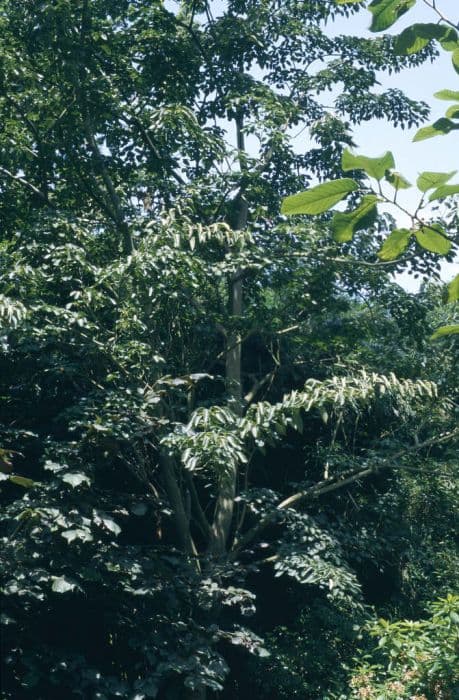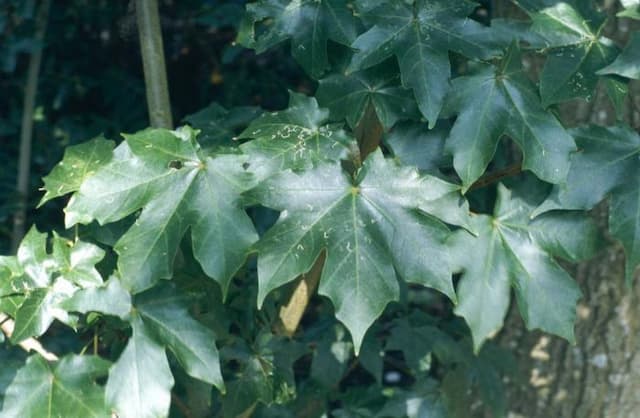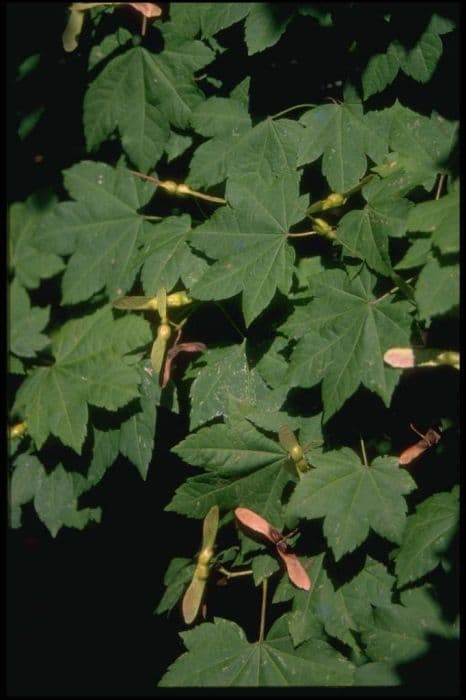Japanese Maple Acer palmatum 'Dissectum Atropurpureum' (D)

ABOUT
The Japanese Maple 'Dissectum Atropurpureum' is a striking ornamental plant known for its delicate and lace-like foliage. This variety boasts a rich, purple-red color that intensifies to deeper shades in the autumn, creating a dramatic display in any garden setting. The leaves are finely dissected, meaning they are cut into numerous narrow lobes, giving them an almost feathery appearance. This delicate leaf shape is further accentuated by the intricate branching pattern of the plant, which is typically gracefully arching or weeping, contributing to its elegant and refined presence. The Japanese Maple 'Dissectum Atropurpureum' often develops a rounded and mound-like form, making it an attractive focal point throughout the year. In spring, it is graced with tiny reddish flowers, adding an extra touch of beauty before the leaves fully emerge. As the seasons change, this Japanese Maple continuously offers visual interest with its outstanding leaf texture and colors.
About this plant
 Names
NamesFamily
Sapindaceae.
Synonyms
Japanese Maple, Laceleaf Japanese Maple, Threadleaf Japanese Maple, Cutleaf Japanese Maple, Weeping Japanese Maple, Red Japanese Maple.
Common names
Acer palmatum var. dissectum 'Atropurpureum'.
 Toxicity
ToxicityTo humans
The Japanese Maple is generally not considered toxic to humans. Ingestion of any part of the plant typically does not result in poisoning or serious consequences for humans.
To pets
The Japanese Maple is also not considered toxic to pets. It is generally regarded as safe, and ingestion should not result in significant symptoms of poisoning or severe health complications in pets.
 Characteristics
CharacteristicsLife cycle
Perennials
Foliage type
Deciduous
Color of leaves
Purple
Height
4 feet (1.2 meters)
Spread
4 feet (1.2 meters)
Plant type
Tree
Hardiness zones
5
Native area
Japan
Benefits
 General Benefits
General Benefits- Aesthetic Appeal: The Japanese Maple lends vibrant color and delicate textures to the landscape with its deep burgundy foliage.
- Seasonal Interest: Offers year-round visual interest with its changing leaf colors and attractive winter bark.
- Compact Size: Its relatively small stature makes it well-suited for smaller gardens or limited spaces.
- Shade Tolerance: This variety can thrive in partial shade, providing flexibility in garden design.
- Cultural Significance: It's associated with peace and serenity in Japanese culture, enhancing the thematic value of a garden.
- Wildlife Habitat: Can offer shelter and food for birds and beneficial insects within the garden ecosystem.
- Low Maintenance: Once established, these trees require minimal care and pruning, ideal for gardeners of all levels.
- Versatility: Can be used in a variety of landscape designs, including Japanese gardens, contemporary, or woodland settings.
- Durability: Resistant to pests and diseases, which helps in maintaining a healthy garden with less chemical intervention.
- Erosion Control: Their root system can help in stabilizing soil on slopes, reducing the risk of soil erosion.
 Medical Properties
Medical PropertiesThis plant is not used for medical purposes.
 Air-purifying Qualities
Air-purifying QualitiesThis plant is not specifically known for air purifying qualities.
 Other Uses
Other Uses- Japanese maple bonsai: With its fine, delicate foliage and dark stems, 'Dissectum Atropurpureum' can be trained into an elegant bonsai that offers year-round interest and beauty.
- Photography subject: The unique shape and color of the leaves make this Japanese maple a favorite among photographers looking for contrasts in nature-related themes.
- Theme gardens: This cultivar is a popular choice for Asian or Japanese-themed gardens, contributing to an atmosphere of tranquility and artistic layout.
- Urban landscaping: Its small size and non-invasive roots make it suitable for urban gardens and street landscaping, providing aesthetic appeal without disrupting pavements or buildings.
- Feng shui enhancement: In the practice of feng shui, the Japanese maple's elegant structure can be used to enhance the flow of energy in a garden or home setting.
- Seasonal celebrations: The striking autumn color of the leaves makes 'Dissectum Atropurpureum' a symbol of change and is used in deco for seasonal displays and celebrations.
- Backdrop in art: Artists may use this plant as a backdrop for their works or as a live model to draw or paint, capturing its intricate foliage details and colors.
- Container gardening: Due to its compact size, it is well-suited for growing in containers on patios or balconies where ground space is limited.
- Wedding decor: Its beautifully colored foliage is sometimes incorporated into wedding décor themes, especially for outdoor or fall weddings.
- Education: Horticulturists and educators use the Japanese maple as an example to teach about plant physiology and the impact of genetics on leaf morphology.
Interesting Facts
 Feng Shui
Feng ShuiJapanese Maple is not used in Feng Shui practice.
 Zodiac Sign Compitability
Zodiac Sign CompitabilityJapanese Maple is not used in astrology practice.
 Plant Symbolism
Plant Symbolism- Peace: The Japanese maple, with its calm presence and grace, is often associated with peace and tranquility.
- Beauty: The stunning foliage, especially in the fall, symbolizes beauty and magnificence in nature.
- Balance: With its symmetrical shape and harmonious growth, the Japanese maple represents balance and practicality in life.
- Endurance: Capable of withstanding cold climates and living for many years, the Japanese maple symbolizes endurance and longevity.
- Welcoming: In some cultures, the Japanese maple is planted near homes to symbolize a warm welcome to guests.
 Water
WaterThe Japanese Maple should be watered deeply but infrequently, ensuring that the soil is kept consistently moist but never waterlogged. In the first growing season, it's crucial to establish a strong root system, so water the plant every week with about 1 to 1.5 gallons of water. After establishment, reduce the frequency to every two to three weeks, depending on the weather conditions, with less water required during rainy periods and more during drought. In extremely hot summers, additional watering may be necessary to prevent stress. Always check the top 2 to 3 inches of soil for dryness before watering again.
 Light
LightJapanese Maples prefer a spot with dappled sunlight or partial shade, especially in the afternoon when the sun is at its strongest. They can tolerate full sun in cooler climates, but in hotter regions, protection from intense midday sun is essential to prevent leaf scorch.
 Temperature
TemperatureThe Japanese Maple thrives in a temperature range of 60°F to 80°F, and it can tolerate a minimum temperature down to -20°F once fully established. However, sudden frosts after new leaves have developed in spring can damage the foliage. Ideally, provide protection from harsh winter winds and extreme summer heat.
 Pruning
PruningPrune Japanese Maples to remove dead or crossing branches and to shape the plant for aesthetic purposes, performing this task in late winter or early spring before new growth begins. Annual light pruning is recommended, while more extensive shaping should be done infrequently to maintain the tree's natural form. Avoid heavy pruning as this can stimulate excessive growth that detracts from the tree's beauty.
 Cleaning
CleaningAs needed
 Soil
SoilThe Japanese Maple 'Dissectum Atropurpureum' thrives best in well-draining soil that is rich in organic matter with a slightly acidic to neutral pH, ideally ranging from 6.0 to 7.5. A mix composed of 1/3 peat moss, 1/3 pine bark, and 1/3 coarse sand or perlite is beneficial for both aeration and moisture retention, providing the roots with an ideal growing environment. Regular amending with organic compost can further enrich soil fertility for optimal growth.
 Repotting
RepottingJapanese Maple 'Dissectum Atropurpureum' should be repotted every two to three years to ensure the root system has sufficient space to grow. Younger trees tend to grow faster and may need to be repotted more frequently, whereas mature trees can be repotted less often. It's best to repot in late winter or early spring, just before the growing season begins.
 Humidity & Misting
Humidity & MistingJapanese Maple 'Dissectum Atropurpureum' prefers moderate humidity levels but is adaptable to various humidity conditions typical of temperate climates. While specific humidity levels are not critical, providing a location with good air circulation and avoiding overly dry conditions is beneficial for the overall health of the plant.
 Suitable locations
Suitable locationsIndoor
Grow in bright, indirect light; keep away from drafts.
Outdoor
Plant in dappled shade, protect from strong winds.
Hardiness zone
5-8 USDA
 Life cycle
Life cycleThe Japanese Maple 'Dissectum Atropurpureum' begins its life as a seed, which, when sown, will germinate in favorable conditions of moisture and temperature. Upon sprouting, the seedling grows into a young sapling, developing its characteristic deeply lobed, purple-red leaves that change throughout the seasons. As it matures, the small tree establishes a strong root system and a weeping form, with its branches gracefully arching downwards. This cultivar reaches maturity after several years, when it starts to produce small reddish-purple flowers in spring, followed by samaras, or winged seeds. These seeds are then dispersed by wind and, if they land in a suitable environment, can give rise to new plants. Throughout its life cycle, the Japanese Maple 'Dissectum Atropurpureum' may be pruned to maintain shape and size, and it will go dormant annually in colder climates during the winter months before resuming growth in the spring.
 Propogation
PropogationPropogation time
Spring
For the Japanese Maple, specifically the 'Dissectum Atropurpureum' variety, the most popular method of propagation is through softwood cuttings taken during late spring to early summer. Cut a section of the stem about 4-6 inches (10-15 centimeters) long with at least two sets of leaves. Remove the leaves from the lower half of the cutting, dip the cut end into a rooting hormone, and insert it into a pot filled with a mix of peat and perlite. Cover the cutting and pot with a plastic bag to maintain humidity and place it in indirect light. Roots typically develop in a few weeks, after which the cutting can gradually be acclimated to the outside environment.








